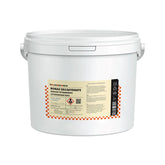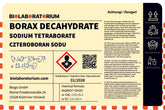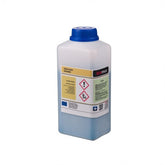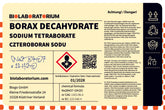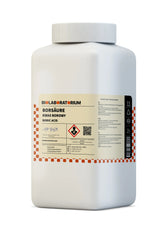Dithizone – a versatile reagent for heavy metal analysis
Dithizone, also known as diphenylthiocarbazone, is a classic reagent in chemical analysis, primarily used for the determination of heavy metals. This fascinating molecule forms intensely colored complexes with a variety of transition metals, enabling rapid and precise quantification of these elements. In this blog post, we will take a closer look at the properties and application possibilities of dithizone.
The Chemistry of Dithizone
Dithizone is an organic compound belonging to the class of thiocarbonylhydrazones. The name is derived from the Greek 'di' (two) and 'thio' (sulfur), as the molecule contains two sulfur atoms. The chemical structure of dithizone is relatively complex but can be simplified as an aromatic system with a hydrazine group and two thiol groups.
This unique structure enables dithizone to form stable complexes with a variety of metal ions. In this process, the sulfur atoms and the nitrogen atom of the hydrazine group coordinate to the metal center, resulting in intensely colored chelate complexes. The color of these complexes depends on the respective metal ion and ranges from red through violet to blue.
Complex formation with heavy metals
Dithizone is particularly known for its high affinity for heavy metals such as lead, cadmium, copper, mercury, nickel, and zinc. These ions form extremely stable complexes with dithizone, which can be easily detected photometrically or spectroscopically. The complex formation constants are mostly in the range of 10^10 to 10^20, which explains the selectivity and sensitivity of the detection.
The mechanism of complex formation can be simplified as follows:
- The dithizone molecule initially exists in its enol form, where the thiol groups are protonated.
- Upon addition of the metal ion, deprotonation of the thiol groups occurs and coordination to the metal center takes place.
- This results in a planar, intensely colored chelate complex that can be detected photometrically or spectroscopically.
The selectivity and sensitivity of the dithizone detection depend on various factors, such as pH, ionic strength, and the presence of competing ions. However, by clever selection of analysis conditions, the method can be optimized for a wide range of applications.
Analytical applications of dithizone
Due to its excellent complex formation properties, dithizone finds diverse applications in chemical analysis. Particularly in trace analysis of heavy metals, the dithizone method has become established and is still routinely used today.
Photometric determination of heavy metals
One of the main applications of dithizone is the photometric determination of heavy metals. In this process, the sample is treated with a dithizone solution, resulting in the formation of the characteristic colored complex. Subsequently, the concentration of the metal can be quantified by measuring the absorption at the specific wavelength of the complex.
This method is characterized by its high sensitivity, selectivity, and simplicity. Typical detection limits are in the range of 0.1 to 1 μg/L, depending on the metal and sample composition. Furthermore, the method can be easily automated and is therefore well-suited for routine analysis.
Extraction and enrichment of heavy metals
In addition to direct photometric determination, dithizone can also be used for selective extraction and enrichment of heavy metals. For this purpose, the sample is first treated with dithizone solution, whereby the metal ions are converted into the dithizone complex.
Subsequently, this complex can be separated from the aqueous phase by extraction with an organic solvent such as chloroform or dichloromethane. This allows efficient separation and enrichment of heavy metals from the matrix, significantly increasing the sensitivity and selectivity of the analysis.
The extracted metal complexes can then be determined either directly by photometry or after back-extraction into the aqueous phase using other analytical methods such as atomic absorption spectroscopy (AAS) or inductively coupled plasma mass spectrometry (ICP-MS).
Further applications
In addition to the main applications mentioned, dithizone is also used in other areas of chemical analysis:
- Thin-layer chromatography: Dithizone can be used for selective staining of heavy metals on thin-layer chromatograms.
- Complexometry: Dithizone can be used in complexometric titrations for the determination of heavy metals.
- Environmental Analysis: The dithizone method is frequently used to determine heavy metal contamination in soils, sediments, and water bodies.
- Clinical Chemistry: In medical analysis, dithizone is used for the determination of heavy metals in blood or urine.
Advantages and Disadvantages of Dithizone
Like any analytical method, the use of dithizone in heavy metal analysis has advantages and disadvantages that must be considered:
Advantages:
- High selectivity and sensitivity for many heavy metals
- Simple and cost-effective implementation
- Good suitability for routine analyses
- Possibility for extraction and enrichment
- Broad range of applications in various fields
Disadvantages:
- Possible interferences from other ions
- Sensitivity to pH changes
- Toxicity of the dithizone reagent and organic solvents
- Relatively high consumption of chemicals
To minimize these disadvantages, careful method optimization and validation are required. Furthermore, when using dithizone, applicable safety regulations must be observed to avoid health and environmental risks.
Conclusion
Dithizone is a versatile and powerful reagent that has been successfully used for decades in chemical analysis for the determination of heavy metals. Its high selectivity and sensitivity, combined with its simple handling, make it a valuable tool in trace analysis.
Although modern instrumental methods such as ICP-MS have gained importance in recent years, the dithizone method remains an important part of the analytical method spectrum due to its robustness, cost efficiency, and broad applicability. With proper optimization and validation, dithizone can continue to be successfully used in heavy metal analysis in the future.

